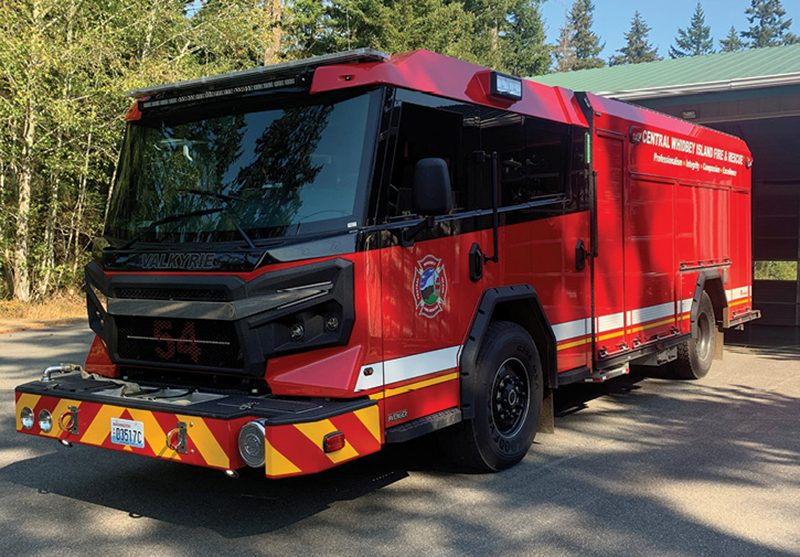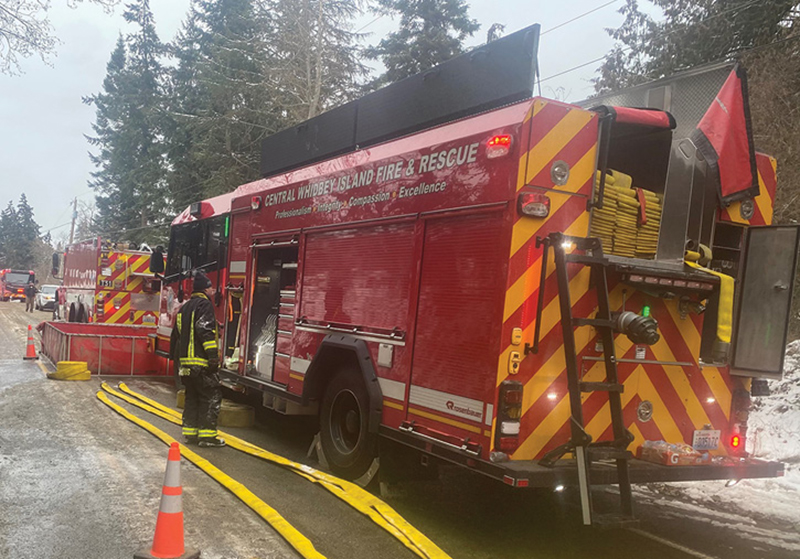Central Whidbey Island (WA) Fire & Rescue is one of five fire departments on Whidbey Island, two hours north of Seattle.

Central Whidbey’s district covers 50 square miles, which the department accomplishes from three stations staffed by full-time and part-time paid firefighters as well as volunteer firefighters.
When the department outgrew its main station and its previous pumpers began showing their age and having increasing maintenance costs, the department proposed a bond to the taxpayers that passed to fund construction of a new main station and purchase three engines.
“The biggest driver for us was to stay on budget with the purchase of the pumpers,” says Jerry Helm, Central Whidbey Island’s chief. “We got three bids for the pumpers and chose Rosenbauer to build them, and they turned out to be the perfect engines for us. Rosenbauer was very good to work with during the build, where they allowed us to bring our mechanic to inspection visits when we were able to help design things that would make the mechanic’s life easier during maintenance, like better pump access.”
Tony Trewin, project manager at Rosenbauer America, says the Central Whidbey Island pumpers are built on Avenger chassis with MP3-style bodies and 24-inch enclosed pump houses. “All the sealed lever bank controls are in the L1 compartments, which are partitioned off, with the forward side for the levers and the back side for adapters and tools,” Trewin points out. “The discharges and intakes are the only external part of the pump house, which allows for a full-depth R1 compartment on the right side as well.”
Each pumper has a wheelbase of 195 inches, an overall length of 32 feet 8 inches, and an overall height of 9 feet 10 inches and carries a 1,500-gallon per minute (gpm) Hale pump, a Trident air primer, a 750-gallon polyurethane water tank, a 30-gallon foam tank, and a FoamPro 2001 foam proportioning system.
Brenden Feist, president and chief executive officer at General Fire Apparatus, who sold the three engines to Central Whidbey Island, says that the fire department had a very specific design that it wanted, especially a shorter wheelbase engine but not lacking for storage space. “Rosenbauer worked with them in how they wanted their cab, discharges, and hosebed laid out, because the chief is very particular in serving the needs of the firefighters and keeping them safe,” Feist says.

1 Rosenbauer built three engines for Central Whidbey Island (WA) Fire & Rescue on Avenger chassis with MP3-style bodies and cabs with seating for four firefighters. (Photos 1-2 courtesy of Rosenbauer.)
department
Central Whidbey Island (WA) Fire & Rescue
Strength: Combination department with 10 full-time paid firefighters and six part-time paid firefighters, all cross-trained as emergency medical technicians, and 20 volunteer firefighters; three fire stations.
Service area: Provides fire, rescue, and basic life support emergency medical services to a 50-square-mile area with a population of 9,500 responding to 1,850 to 1,900 calls per year.
Other apparatus: Four Type 1 engines (one in reserve), three water tenders (tankers), two Type 5 wildland brush trucks, one 27-foot rescue boat, one BLS ambulance, three chief/staff cars.

2 The engines each have a Hale 1,500-gpm pump, 750-gallon water tank, 30-gallon foam tank, and FoamPro 2001 foam proportioning system.

3 The three Rosenbauer engines are named after characters in the Avenger film series. (Photos 3-7 courtesy of Central Whidbey Island Fire & Rescue.)

4 The pump panel on the Rosenbauer pumpers for Central Whidbey Island.

Helm notes that each engine has two 200-foot 1¾-inch hose and two 200-foot 2-inch hose crosslays, along with a 100-foot 1¾-inch hoseline in the front bumper to which firefighters can attach a Fognail fine water mist attack pack and a Task Force Tips Hurricane deck gun with a manual 18-inch TFT Extend-A-Gun.
The engine’s hosebed carries 1,100 feet of 5-inch large-diameter hose (LDH) flat loaded, 800 feet of 3-inch hose loaded in 100-foot shoulder bundles for use as a reverse lay, 150 feet of 3-inch hose preconnected with a Task Force Tips Blitzfire® nozzle, and two 150-foot 1¾-inch hose standpipe packs. The hosebed has hard covers over it and its four coffin compartments.
“We have a compartment on the upper left side of the rear of each engine that holds our two hard suction sections, one of which has a strainer preattached so we can put it directly into a drop tank,” Helm says. “The right side has a ladder compartment holding a 10-foot attic ladder, a 14-foot roof ladder, on two of the engines a 24-foot two-section extension ladder, and on the third engine a 35-foot three-section extension ladder.”
Helm points out the two engines with the 24-foot extension ladders are housed in the department’s two outlying stations that are staffed by volunteer firefighters. “We wanted those stations to have the 24-footers that can be handled more easily than the 35-footer, which is on the engine in the career station in the center of the district,” he says.
5 The front bumpers on the Avenger engines have a 100-foot 1¾-inch preconnected hoseline to which firefighters can attach a Fognail fine water mist attack nozzle.

6 One of the new Rosenbauer engines operating at a scene with a water tender.

7 Two of Central Whidbey Island’s Avenger engines at a fire scene with a water tender between them.
specs
Rosenbauer Avenger Pumper
- Rosenbauer Avenger chassis, MP3-style body and cab with seating for four firefighters, three in SCBA seats
- Wheelbase: 195 inches
- Overall length: 32 feet 8 inches
- Overall height: 9 feet 10 inches
- Hale 1,500-gpm pump
- Trident air primer
- 750-gallon polyurethane water tank
- 30-gallon foam tank
- FoamPro 2001 foam proportioning system
- Task Force Tips Hurricane deck gun with 18-inch Extend-A-Gun
The cab on the pumpers is set up to carry four firefighters, three of them in self-contained breathing apparatus (SCBA) seats, while the driver’s SCBA is mounted in a side compartment. The cab also holds two fold-down jump seats outboard of the SCBA seats on the back wall and two emergency medical services (EMS) cabinets that face the folding seats and are accessible from inside the cab.
Helm says the Avenger in the main station that has the 35-foot ladder also carries Holmatro battery-operated rams, a spreader, and a cutter as well as Milwaukee Tools drills, lights, vent fans, and rope rescue equipment that firefighters use on the island’s bluffs and hilly terrain.
“The engines have been in service for about a year, and we are absolutely pleased with their performance,” Helm points out. “Their weight balance is very nice; they handle very well and have a very tight turning radius.”
Helm notes that when the engines were being built, the department asked Rosenbauer to name each of them after a character in the Avenger film series. “So, our engines are named Thor, Loki, and Valkyrie,” he says. “And we were surprised at the huge public reaction that we got with naming the engines. The public absolutely loves it.”
ALAN M. PETRILLO is a Tucson, Arizona-based journalist, the author of three novels and five nonfiction books, and a member of the Fire Apparatus & Emergency Equipment Editorial Advisory Board. He served 22 years with the Verdoy (NY) Fire Department, including in the position of chief.

